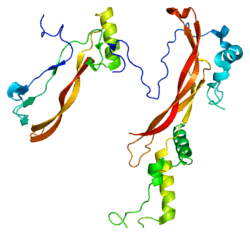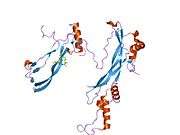Noggin (protein)
| View/Edit Human | View/Edit Mouse |
Noggin, also known as NOG, is a protein that is involved in the development of many body tissues, including nerve tissue, muscles, and bones. In humans is encoded by the NOG gene.[3] The amino acid sequence of human noggin is highly homologous to that of rat, mouse, and Xenopus (an aquatic-frog genus).
The protein's name, which is a slang English-language word for "head," was coined in reference to its ability to produce embryos with large heads when exposed at high concentrations.[4]
Function
Noggin is a signaling molecule that plays an important role in promoting somite patterning in the developing embryo.[5] It is released from the notochord and regulates bone morphogenic protein during development.[6] The absence of BMP4 will cause the patterning of the neural tube and somites from the neural plate in the developing embryo. It also causes formation of the head and other dorsal structures.[6]
Noggin function is required for correct nervous system, somite, and skeletal development.[6] Experiments in mice have shown that noggin also plays a role in learning, cognition, bone development, and neural tube fusion. Heterozygous missense mutations in the noggin gene can cause deformities such as joint fusions and syndromes such as multiple synostosis syndrome (SYNS1) and proximal symphalangism (SIM1).[6] SYNS1 is different from SYM1 by causing hip and vertebral fusions.[6] The embryo may also develop shorter bones, miss any skeletal elements, or lack multiple articulating joints.[6]
Mechanism of action
The secreted polypeptide noggin, encoded by the NOG gene, binds and inactivates members of the transforming growth factor-beta (TGF-beta) superfamily signaling proteins, such as bone morphogenetic protein-4 (BMP4).
By diffusing through extracellular matrices more efficiently than members of the TGF-beta superfamily, noggin may have a principal role in creating morphogenic gradients. Noggin appears to have pleiotropic effects, both early in development as well as in later stages.
Knockout model
A mouse knockout model was studied tracking the extent to which the absence of noggin on the embryological development. The focus of the model was the ear formation and its cause in conductive hearing loss. The inner ear underwent multiple deformations affecting the cochlear duct, semilunar canal, and otic capsule portions. Noggin was also shown to be indirectly involved in the malformations through its interaction with the notochord and neural axis. The kinking of the notochord and disorientation of the body axis results in a caudal shift in the embryonic body plan of the hindbrain. Major signaling molecules from the rhombomere structures in the hindbrain could not properly induce inner ear formation. This reflected noggin's regulating role of BMP as the major source of deformation rather than noggin having a direct effect on inner ear development.[7]
Clinical significance
Noggin proteins play a role in germ layer-specific derivation of specialized cells. The formation of neural tissues, the notochord, hair follicles, and eye structures arise from the ectoderm germ layer. Noggin activity in the mesoderm gives way to the formation of cartilage, bone and muscle growth, and in the endoderm noggin is involved in the development of the lungs.[8]
Early craniofacial development is heavily influenced by the presence of noggin in accordance with its multiple tissue-specific requirements. Noggin influences the formation and growth of the palate, mandible and skull through its interaction with neural crest cells. Mice with a lack of NOG gene are shown to have an outgrowth of the mandible and a cleft palate. Another craniofacial related deformity due to the absence of noggin is conductive hearing loss caused by uncontrolled outgrowth of the cochlear duct and coiling.[9]
Recently, several heterozygous missense human NOG mutations in unrelated families with proximal symphalangism (SYM1) and multiple synostoses syndrome (SYNS1) have been identified; both SYM1 and SYNS1 have multiple joint fusion as their principal feature, and map to the same region on chromosome 17 (17q22) as NOG. These mutations indicate functional haploinsufficiency where the homozygous forms are embryonically lethal.[8]
All these NOG mutations have altered evolutionarily conserved amino acid residues.
Discovery
Noggin was originally isolated from the aquatic-frog genus Xenopus. The discovery was based on the organism's ability to restore normal dorsal-ventral body axis in embryos that had been artificially ventralized by UV treatment. Noggin was discovered in the laboratory of Richard M. Harland and William C. Smith at the University of California, Berkeley because of this ability to induce secondary axis formation in frog embryos.[10]
References
- ↑ "Human PubMed Reference:".
- ↑ "Mouse PubMed Reference:".
- ↑ "Entrez Gene: NOG noggin".
- ↑ Oppenheimer SB (1995). "The Discovery of Noggin". The American Biology Teacher. 57 (5): 264. doi:10.2307/4449989. JSTOR 4449989.
- ↑ Hirsinger E, Duprez D, Jouve C, Malapert P, Cooke J, Pourquié O (Nov 1997). "Noggin acts downstream of Wnt and Sonic Hedgehog to antagonize BMP4 in avian somite patterning". Development. 124 (22): 4605–14. PMID 9409677.
- 1 2 3 4 5 6 Marcelino J, Sciortino CM, Romero MF, Ulatowski LM, Ballock RT, Economides AN, Eimon PM, Harland RM, Warman ML (Sep 2001). "Human disease-causing NOG missense mutations: effects on noggin secretion, dimer formation, and bone morphogenetic protein binding". Proceedings of the National Academy of Sciences of the United States of America. 98 (20): 11353–8. doi:10.1073/pnas.201367598. PMC 58733
 . PMID 11562478.
. PMID 11562478. - ↑ Bok J, Brunet LJ, Howard O, Burton Q, Wu DK (Nov 2007). "Role of hindbrain in inner ear morphogenesis: analysis of Noggin knockout mice". Developmental Biology. 311 (1): 69–78. doi:10.1016/j.ydbio.2007.08.013. PMID 17900554.
- 1 2 Krause C, Guzman A, Knaus P (Apr 2011). "Noggin". The International Journal of Biochemistry & Cell Biology. 43 (4): 478–81. doi:10.1016/j.biocel.2011.01.007. PMID 21256973.
- ↑ Masuda S, Namba K, Mutai H, Usui S, Miyanaga Y, Kaneko H, Matsunaga T (2014). "A mutation in the heparin-binding site of noggin as a novel mechanism of proximal symphalangism and conductive hearing loss". Biochemical and Biophysical Research Communications. 447 (3): 496–502. doi:10.1016/j.bbrc.2014.04.015. PMID 24735539.
- ↑ Valenzuela DM, Economides AN, Rojas E, Lamb TM, Nuñez L, Jones P, Lp NY, Espinosa R, Brannan CI, Gilbert DJ (Sep 1995). "Identification of mammalian noggin and its expression in the adult nervous system". The Journal of Neuroscience. 15 (9): 6077–84. PMID 7666191.
Further reading
- Polymeropoulos MH, Poush J, Rubenstein JR, Francomano CA (May 1995). "Localization of the gene (SYM1) for proximal symphalangism to human chromosome 17q21-q22". Genomics. 27 (2): 225–9. doi:10.1006/geno.1995.1035. PMID 7557985.
- McMahon JA, Takada S, Zimmerman LB, Fan CM, Harland RM, McMahon AP (May 1998). "Noggin-mediated antagonism of BMP signaling is required for growth and patterning of the neural tube and somite". Genes & Development. 12 (10): 1438–52. doi:10.1101/gad.12.10.1438. PMC 316831
 . PMID 9585504.
. PMID 9585504. - Brunet LJ, McMahon JA, McMahon AP, Harland RM (May 1998). "Noggin, cartilage morphogenesis, and joint formation in the mammalian skeleton". Science. 280 (5368): 1455–7. doi:10.1126/science.280.5368.1455. PMID 9603738.
- Krakow D, Reinker K, Powell B, Cantor R, Priore MA, Garber A, Lachman RS, Rimoin DL, Cohn DH (Jul 1998). "Localization of a multiple synostoses-syndrome disease gene to chromosome 17q21-22". American Journal of Human Genetics. 63 (1): 120–4. doi:10.1086/301921. PMC 1377242
 . PMID 9634519.
. PMID 9634519. - Smith WC (Jan 1999). "TGF beta inhibitors. New and unexpected requirements in vertebrate development". Trends in Genetics. 15 (1): 3–5. doi:10.1016/S0168-9525(98)01641-2. PMID 10087923.
- Gong Y, Krakow D, Marcelino J, Wilkin D, Chitayat D, Babul-Hirji R, Hudgins L, Cremers CW, Cremers FP, Brunner HG, Reinker K, Rimoin DL, Cohn DH, Goodman FR, Reardon W, Patton M, Francomano CA, Warman ML (Mar 1999). "Heterozygous mutations in the gene encoding noggin affect human joint morphogenesis". Nature Genetics. 21 (3): 302–4. doi:10.1038/6821. PMID 10080184.
- Li W, LoTurco JJ (2000). "Noggin is a negative regulator of neuronal differentiation in developing neocortex". Developmental Neuroscience. 22 (1-2): 68–73. doi:10.1159/000017428. PMID 10657699.
- Dixon ME, Armstrong P, Stevens DB, Bamshad M (2002). "Identical mutations in NOG can cause either tarsal/carpal coalition syndrome or proximal symphalangism". Genetics in Medicine. 3 (5): 349–53. doi:10.1097/00125817-200109000-00004. PMID 11545688.
- Marcelino J, Sciortino CM, Romero MF, Ulatowski LM, Ballock RT, Economides AN, Eimon PM, Harland RM, Warman ML (Sep 2001). "Human disease-causing NOG missense mutations: effects on noggin secretion, dimer formation, and bone morphogenetic protein binding". Proceedings of the National Academy of Sciences of the United States of America. 98 (20): 11353–8. doi:10.1073/pnas.201367598. PMC 58733
 . PMID 11562478.
. PMID 11562478. - Paine-Saunders S, Viviano BL, Economides AN, Saunders S (Jan 2002). "Heparan sulfate proteoglycans retain Noggin at the cell surface: a potential mechanism for shaping bone morphogenetic protein gradients". The Journal of Biological Chemistry. 277 (3): 2089–96. doi:10.1074/jbc.M109151200. PMID 11706034.
- Takahashi T, Takahashi I, Komatsu M, Sawaishi Y, Higashi K, Nishimura G, Saito H, Takada G (Dec 2001). "Mutations of the NOG gene in individuals with proximal symphalangism and multiple synostosis syndrome". Clinical Genetics. 60 (6): 447–51. doi:10.1034/j.1399-0004.2001.600607.x. PMID 11846737.
- Mangino M, Flex E, Digilio MC, Giannotti A, Dallapiccola B (Mar 2002). "Identification of a novel NOG gene mutation (P35S) in an Italian family with symphalangism". Human Mutation. 19 (3): 308. doi:10.1002/humu.9016. PMID 11857750.
- Brown DJ, Kim TB, Petty EM, Downs CA, Martin DM, Strouse PJ, Moroi SE, Milunsky JM, Lesperance MM (Sep 2002). "Autosomal dominant stapes ankylosis with broad thumbs and toes, hyperopia, and skeletal anomalies is caused by heterozygous nonsense and frameshift mutations in NOG, the gene encoding noggin". American Journal of Human Genetics. 71 (3): 618–24. doi:10.1086/342067. PMC 379196
 . PMID 12089654.
. PMID 12089654. - Hall AK, Burke RM, Anand M, Dinsio KJ (Jul 2002). "Activin and bone morphogenetic proteins are present in perinatal sensory neuron target tissues that induce neuropeptides". Journal of Neurobiology. 52 (1): 52–60. doi:10.1002/neu.10068. PMID 12115893.
- Groppe J, Greenwald J, Wiater E, Rodriguez-Leon J, Economides AN, Kwiatkowski W, Affolter M, Vale WW, Izpisua Belmonte JC, Choe S (Dec 2002). "Structural basis of BMP signalling inhibition by the cystine knot protein Noggin". Nature. 420 (6916): 636–42. doi:10.1038/nature01245. PMID 12478285.
- Brown DJ, Kim TB, Petty EM, Downs CA, Martin DM, Strouse PJ, Moroi SE, Gebarski SS, Lesperance MM (Mar 2003). "Characterization of a stapes ankylosis family with a NOG mutation". Otology & Neurotology. 24 (2): 210–5. doi:10.1097/00129492-200303000-00014. PMID 12621334.
External links
- BMPedia - the Bone Morphogenetic Protein Wiki
- Noggin publications, gene expression data, sequences and interactants from Xenbase
- NOG human gene location in the UCSC Genome Browser.
- NOG human gene details in the UCSC Genome Browser.

